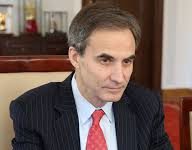By Muhammad Luqman
New York-based credit rating agency Moody’s on has upgraded raised Pakistan’s economic outlook from negative to stable on the back of the country’s reforms supported by an IMF programme, but kept its credit rating unchanged at B3.
“The change in outlook to stable is driven by Moody’s expectations that the balance of payments dynamics will continue to improve, supported by policy adjustments and currency flexibility,” Moody’s Investor Service said, adding that such developments reduce external vulnerability risks, although foreign exchange reserve buffers remain low and will take time to rebuild.
Projecting Pakistan’s fiscal deficit at the end of current fiscal year at 8.6 per cent instead of 7.1pc estimated by the government in the budget for 2019-20, the rating agency noted that fiscal strength had weakened with higher debt levels largely as a result of currency depreciation. However, it expected that the ongoing fiscal reforms, including through the International Monetary Fund programme, would mitigate risks related to debt sustainability and government liquidity.
Dr Abdul Hafeez Shaikh, Adviser to the Prime Minister on Finance, has claimed credit for better outlook forecast by Moody’s, saying it affirmed the government’s success in stabilising the country’s economy and laying a firm foundation for a robust long-term growth.
Moody’s had in June last year lowered Pakistan’s outlook to negative from stable owing to erosion in foreign exchange buffers due to heightened external pressures.
Its representatives had visited Islamabad on Nov 27 and noted that Pakistan’s economic fundamentals, including its economic strength and susceptibility to event risks, had not materially changed even though institutional strength had increased and financial strength decreased.
Moody’s said the rating affirmation reflected Pakistan’s relatively large economy and robust long-term growth potential, coupled with ongoing institutional enhancements that raise policy credibility and effectiveness, albeit from a low starting point. These credit strengths are balanced against structural constraints to economic and export competitiveness, the government’s low revenue generation capacity that weakens debt affordability, fiscal strength that will remain weak over the foreseeable future, as well as political and still-material external vulnerability risks.
Concurrently, Moody’s has affirmed the B3 foreign currency senior unsecured ratings for The Second Pakistan International Sukuk Company Limited and The Third Pakistan International Sukuk Co. Ltd. It said Pakistan’s Ba3 local currency bond and deposit ceilings remain unchanged. The B2 foreign currency bond ceiling and the Caa1 foreign currency deposit ceiling are also unchanged. The short-term foreign currency bond and deposit ceilings remain unchanged at ‘Not Prime’.
Noting that Pakistan’s metrics on the fiscal side weakened recently with wider fiscal deficits and an increase in government’s debt burden largely as a result of currency depreciation over the course of fiscal 2019, Moody’s expected the ongoing fiscal reforms, anchored by the IMF programme and technical assistance from other development partners, to contribute to a gradual narrowing of fiscal deficits.
It expected “the government’s fiscal deficit to remain relatively wide at around 8.6pc of GDP in fiscal 2020, compared to 8.9pc in fiscal 2019, before narrowing to an average of around 7pc over fiscal 2021-23”. High interest payments owing to policy rate hikes will continue to weigh on government finances and significantly constrain fiscal flexibility. Meanwhile, government revenue as a share of GDP, while likely to increase, was growing from a lower base, having declined significantly in fiscal 2019.
Moody’s estimated Pakistan’s current account deficit to continue narrowing in the current and next fiscal years, averaging around 2.2pc of GDP, from more than 6pc in fiscal 2018 and around 5pc in fiscal 2019.
Under Moody’s baseline assumptions, subdued import growth will likely remain the main driver of narrowing current account deficits. In particular, the ongoing completion of power projects will reduce capital goods imports, while oil imports will remain structurally lower given the gradual transition in power generation away from diesel to coal, natural gas and hydropower.
Tight monetary conditions and import tariff on non-essential goods will also weigh on broader import demand for some time, although the rating agency viewed the possibility of monetary conditions easing when inflation gradually declines towards the end of the current fiscal year.
Moody’s expected the policy enhancements, including strengthened central bank independence and the commitment to currency flexibility, to support the reduction in external vulnerability risks. It also appreciated the State Bank of Pakistan for strongly adhering to its commitment to a floating exchange rate regime since May 2019. “These enhancements to the policy framework will foster confidence in the Pakistani rupee, while the use of the exchange rate as a shock absorber increases policy buffers,” it said.
Notwithstanding improved balance of payments dynamics, Pakistan’s foreign exchange reserve adequacy remains low. Foreign exchange reserves have fluctuated around $7-8 billion over the past few months, sufficient to cover just 2-2.5 months of goods imports. Coverage of external debt due also remains low, with the country’s External Vulnerability Indicator — which measures the ratio of external debt due over the next fiscal year to foreign exchange reserves — remaining around 160-180pc.















